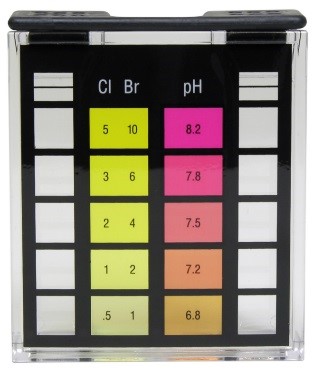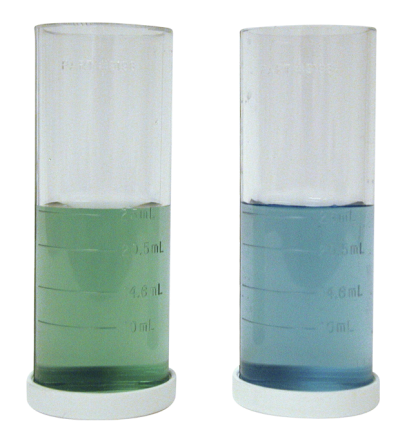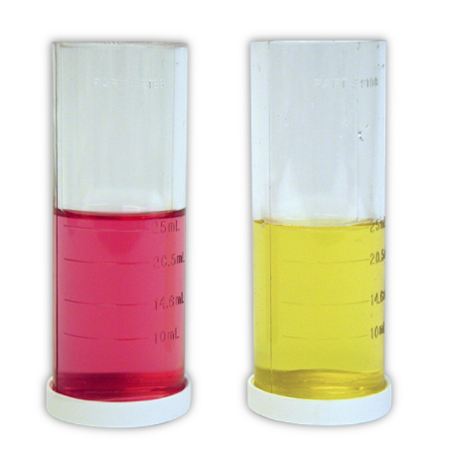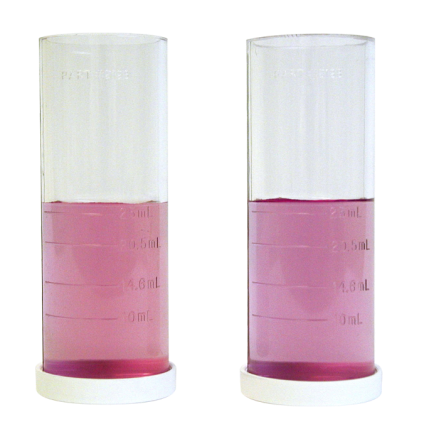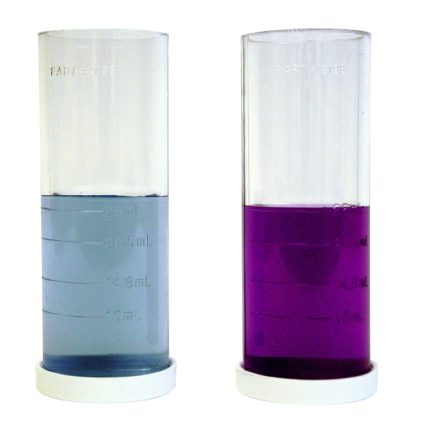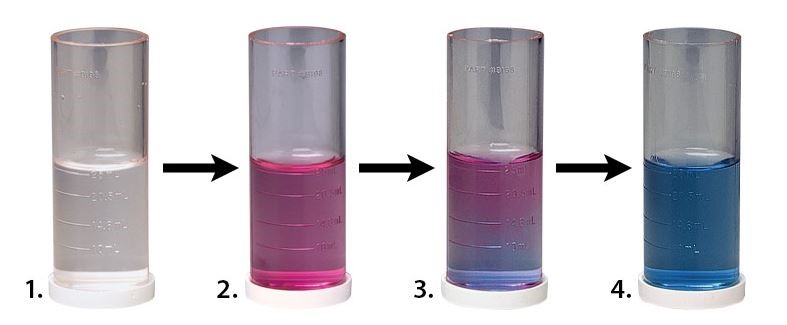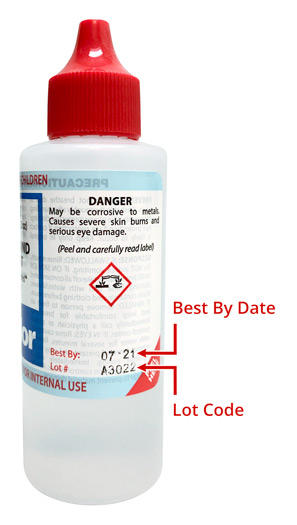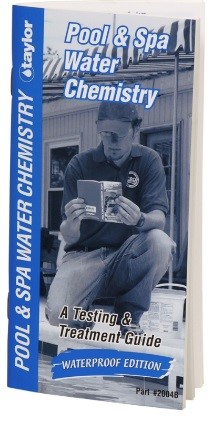
Chlorine | pH | Total Alkalinity | Calcium Hardness | Where To Look | Drop Tests | General FAQ's | PHTA Guidelines | Need Further Assistance?
Chlorine
Sample bleaching out
High sanitizer levels (> 10 ppm) may cause total or partial bleaching resulting in false-low readings. To determine an approximate chlorine concentration, dilute the sample and retest. For a 1:1 dilution, multiply the result by two.
Sample turning cloudy
Cloudiness is caused by a high level of hardness (> 500 ppm) that precipitates out as calcium and/or magnesium salt. To avoid cloudiness, retest this time adding DPD reagents R-0001 and R-0002 first, then carefully adding the sample water to the test cell.
Residual DPD #3
DPD Reagent #3 (R-0003) is used to measure total chlorine. If there is even a small amount of R-0003 left in your test cell from a previous test, it will interfere with your free chlorine reading. Be sure to thoroughly clean the test cell after each use.
DPD vs. OTOT measures total chlorine and DPD measures free and total chlorine. You can tell which reagent your comparator requires by looking at the color standards. OT develops varying yellow shades while DPD develops varying pink shades.
Using a non-chlorine oxidizer containing monopersulfate
Monopersulfate will react with R-0003 resulting in false-total and -combined chlorine readings. We have a kit (K-1520) as well as reagent packs for existing kits (K-2041 and K-2042) that will remove the interference.
Sample color gets darker within a few seconds after testing
The DPD in the sample is oxidizing due to prolonged contact with the air. Readings should always be taken immediately after testing unless otherwise specified in the instructions.
Using a bromine comparator
DPD and OT undergo the same reaction with bromine as with chlorine, but the color intensities produced are different. To convert a bromine reading to chlorine, divide the result by 2.25. To convert a chlorine reading to bromine, multiply the result by 2.25. Taylor offers comparators that measure both bromine and chlorine—no conversions are necessary.
pH
Interchanging R-0004 and R-0014
You cannot interchange these reagents. They are both phenol red indicators but are different concentrations; therefore, they are designed to be used with different comparator blocks. Residential™ comparators require R-0014. 2000 Series™ comparators require R-0004.
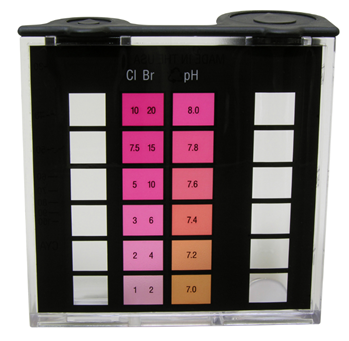
Note: Comparator tests cells are different volumes.
Blue/purple endpoint
A high sanitizer level (>10 ppm) is interfering. Retest, this time adding only one drop Thiosulfate N/10 (R-0007) to the sample first if using a 2000 Series™ comparator. For Residential™ comparators, add one drop of R-0007 to a 50 mL sample; then add that treated sample to the comparator.
Acids effect on pH
Acid lowers pH. Please refer to pages 10, 11, 57 and 58 in the 2004B booklet for more information.
Total Alkalinity
Blue to yellow color development
A high sanitizer level (> 10 ppm) is interfering. Retest, this time adding one extra drop of R-0007 to the sample to remove the interference.
Raising or lowering total alkalinity
Please refer to Tables G and H in your 2004B booklet.
False-high reading due to cyanuric acid
Cyanuric acid (CYA) titrates as total alkalinity when CYA is greater than 30 ppm. Adjust for this by subtracting 1/3 of your CYA reading from your total alkalinity reading to get the correct alkalinity value. For a more detailed explanation, refer to page 14 in your 2004B booklet.
Calcium Hardness
Purple endpoint
There are metal ions interfering with the test: most likely copper or iron ions from algaecides, pipes, or even the water itself. To avoid this problem, add five or six drops of titrant to the sample before adding the buffer and indicator, then proceed normally with the test. Always include the drops of titrant added at the beginning of the test when counting the total number of drops required to reach the endpoint.
Purple dots in sample
The dots are magnesium hydroxide. This is a common reaction and does not interfere with the endpoint color.
Where to Look
SDS sheets
Click here. SDS’s can also be found on the individual product page.
Test strips
All test strip options can be found here.
Test kits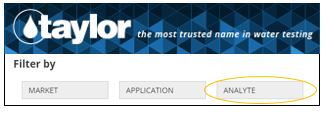
Drop Tests
Drop equivalence
Drop equivalence is the measure of analyte per drop of reagent. You will find the drop equivalence for your test kit in the instructions.
Changing drop equivalence
To change the equivalence of a drop test, you must change the sample size proportionally to the desired change in equivalence. Contact our technical staff before changing the equivalence of any test.
True endpoint
A treated sample will show a mixture of the original color and the endpoint color as the titrant is added until the endpoint is reached. (For instance, you will see both pink- and blue-colored water in your sample midway through a hardness test.) Add one more drop of titrant after the endpoint to be certain the color change was permanent. If the color remains unchanged, do not count this last drop.
General FAQ's
Using other manufacturers' reagents
Each manufacturer makes reagents in different concentrations, and the color standards in the comparators are developed for a specific reagent concentration. To ensure accuracy, always use Taylor reagents with Taylor comparators. There is one exception to this rule—DPD liquids and tablets can be interchanged in most color-matching tests.
Foam in spa water
Foaming water may be caused by excessive use of certain algaecides. Drain the spa partially and refill with fresh water. This will reduce the algaecide concentration and stop the foaming. As a temporary solution, antifoaming agents may be added to the spa water. Too soft water can cause foaming. Add hardness to reach the recommended range to prevent this. High turnover rates may also contribute to foaming. A turnover is the amount of time required to recirculate the entire volume of water in a pool or spa. Check your owner’s manual or contact the manufacturer to verify an appropriate turnover rate for your system.
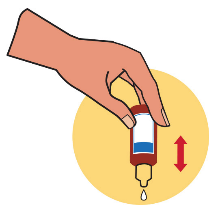
- Hold the bottle vertically to maintain uniform drop size.
- The drop size is 25 drops/mL, +/- one drop.
- A buildup of static electricity at a dropper bottle's tip will cause a visible, progressive decrease in drop size. Periodically wiping around (not over) the dropper tip with a clean damp cloth or paper towel will eliminate this static.
Test kit accuracy
The accuracy for color-matching tests and test strips is ½ the distance between two color standards. The accuracy for drop tests is ± one drop (10%). For meters, see manufacturer’s specification sheet.
Shelf life
You will find the expiration or best by date printed on the label. As with other perishables, reagents and test strips must be stored under controlled environmental conditions. Listed below are some simple rules to help ensure accurate test results:
- Store all reagents and test strips at a consistent temperature between 36°F–85°F (2°C–29°C).
- Keep all reagents and test strips out of direct sunlight.
- Store all reagents and test strips away from treatment chemicals.
- Always replace caps tightly on reagent bottles and test strip containers.
- It is best to replace your reagents and test strips seasonally.
Lighting concerns
Incandescent lighting, fluorescent lighting, and sunglasses make it very difficult to match colors. Always try to perform tests in natural daylight. Hold the comparator at eye level and keep your back to the sun. If testing in natural light is not an option, try our Day Light Comparator Lamp (part #9199).
Lot code
All reagents and test strips have a best by date and lot number printed on the label. Once the item has passed the best by date, we recommend replacing it. The lot number is used internally to determine when products were manufactured.
Cleaning comparators
After a while, you may notice a buildup of residue on the inside of the test cell. Fill the test cell with water and add a couple drops of Sulfuric Acid .12N (R-0009) to the cell. Use a bristle brush to scrub the inside of the cell. Rinse your comparator and discard the brush after use. We recommend replacing your comparator every 2-3 years depending on frequency of use.
K-2005 vs. K-2006
The only difference is the method used for testing chlorine. The K-2005 uses color-matching (DPD) while the K-2006 uses a drop test (FAS-DPD) to determine free, combined, and total chlorine.
Note: To see these methods demonstrated, click here to view our Video Archive.
Approximately how many tests can I get out of a K-2005?
PHTA Guidelines (formerly NSPF)
PHTA recommended guidelines for water quality
The table below presents target ranges for important water chemistry parameters.
| Parameter | Min. | Ideal | Max. |
Who |
| Free Chlorine, ppm | 1.0 | 2.0–4.0 | 5.0 | Pools, Waterparks |
| 2.0 | 3.0–5.0 | 10.0 | Spas | |
| Combined Chlorine, ppm | 0 | 0 | 0.2 | Pools, Waterparks |
| 0 | 0 | 0.5 | Spas | |
| Total Bromine, ppm | 2.0 | 4.0–6.0 | 10.0 | All types |
| PHMB, ppm | 30 | 30–50 | 50 | All types |
|
pH |
7.2 | 7.4–7.6 | 7.8 | All types |
| Total Alkalinity, ppm as CaCO3 | 60 | 80–100* 100–120** |
180 | All types |
| Total Dissolved Solids, ppm | NA | NA | 1,500 over start-up*** |
All types |
| Calcium Hardness, ppm as CaCO3 | 150 | 200–400 | 1,000 | Pools, Waterparks |
| 100 | 150–250 | 800 | Spas | |
| Heavy Metals | None | None | None | All types |
| Visible Algae | None | None | None | All types |
| Bacteria | None | None | Local code | All types |
| Cyanuric Acid, ppm | 0 | 30–50 | **** | All types |
| Temperature, °F | 78°F | 80.5°F | 82°F | Competition pools |
| - | Personal preference | 104°F | Other pools | |
| - | - | 104°F | Spas | |
| Ozone, ppm | - | - | 0.1 over 8 hr. time-wtd. avg. | All types |
| ORP | Calibrate to disinfectant level***** | All types | ||
† These commonly accepted chemical parameters do not supersede product label directions or local or state codes and regulations.
* For calcium hypochlorite, lithium hypochlorite, or sodium hypochlorite.
** For sodium dichlor, trichlor, chlorine gas, BCDMH.
*** Including TDS contribution of salt found in chlorine generating systems.
**** Dictated by state or local codes. Typically 100 ppm. (Some codes are higher, some are lower.)
***** Some state or local codes may dictate a minimum and maximum.
Need Further Assistance?
Call 800-TEST KIT (837-8548) 8:00 a.m. – 5:00 p.m. EST, Monday through Friday (except holidays).
To help you, we will need the following information:
- The type of water you are testing.
- The part number of the Taylor test kit you are using (generally found in the bottom right-hand corner of the case label and begins “K-”).
- If using a kit containing multiple tests, the specific test you need assistance with.
- The name(s) and lot code(s) of the reagents you are using (see reagent label).
- Your question, or the nature of the problem you are experiencing.

